|
|
|
The Simple Truth about the Gender Pay Gap
2017 AAUW Report
Women receive 80 % of the pay for men in the United States. Women in every state experience the pay gap but in some states, it is worse than others. Women face a pay gap in nearly every occupation. More education helps increase women's earnings but it still does not close the gender pay gap which is present for women relative to men at the same educational level. The gender pay gap also grows with age, and differences among older workers are considerably larger than gaps among younger workers. Women typically earn about 90 % of what men are paid until they hit 35. After that median earnings for women are typically 74 - 82 % of what men are paid.
Student Evaluations of Teaching (Mostly) Do Not Measure Teaching Effectiveness
P. B. Stark, A. Boring and K Ottoboni Jan 7 2016
ScienceOpen Research, DOI: 10.14293/S2199-1006.1.SOR-EDU.AETBZC.v1
Student evaluations of teaching (SET) are widely used in academic personnel decisions as a measure of teaching effectiveness. Philip B. Stark, associate dean of the Division of Mathematical and Physical Sciences and a professor of statistics at the University of California at Berkeley and his colleagues performed advanced statistical analyses of five years' worth of data to which Boring had access regarding 23,001 evaluations of 379 instructors by 4,423 students in six mandatory first-year courses at a French university. They also applied the tests to evaluations for four sections of an online course in a randomized, controlled, blind experiment at a U.S. university. The authors show:
• SET are biased against female instructors by an amount that is large and statistically significant
• the bias affects how students rate even putatively objective aspects of teaching, such as how promptly assignments are graded
• the bias varies by discipline and by student gender, among other things
Stark and his co-authors found that the association between evaluations and a more objective measure of teaching effectiveness -- student performance on an anonymously graded final in the French data set (grades were not linked to the evaluations in the U.S. set) -- is weak, and not statistically significant. Yet the association between evaluations and perceived instructor gender in both the U.S. and French data sets is largely statistically significant: instructors whom students believe are male receive significantly higher average ratings.
College students 'assessments of their instructors' teaching ability is linked to whether they think those instructors are male or female
L. MacNell, A. Driscoll, A. N. Hunt 2015
What's in a Name: Exposing Gender Bias in Student Ratings of Teaching, Innovative Higher Education 2015, 40(4) 291-303. DOI:10.1007/s10755-014-9313-4
It is difficult when evaluating teaching to isolate the instructor's gender from other factors that influence class instruction, such as teaching style. That's where online education comes in. Unlike those doing research on face-to-face instruction, researchers in this study were able to hide the gender of the instructors, and to keep equal all the teaching components, such as grading standards and the speed of responses. To conduct the study, researchers compared instructor evaluations of four discussion groups in a technology and society class within the sociology and anthropology department at North Carolina State. Two groups were taught by a female instructor and two were taught by a male instructor. Students in one of the female instructor's groups were told their instructor was male, and vice versa.
Neither the actual male nor actual female instructor received significantly higher ratings. But the same instructors received different ratings when they "switched" genders. The male instructor had lower ratings when students were told their instructor was female. The female instructor had higher ratings when students were told their instructor was male. Students in the online course gave better evaluations to the instructors they thought were male. When comparing the evaluations of the perceived gender identities, the male identity received higher scores across all 12 variables students evaluated. In six variables -- professionalism, promptness, fairness, respectfulness, enthusiasm and giving praise -- the differences were statistically significant. In promptness, for example, the instructors matched their grading schedules so that students in all groups received feedback at about the same rate. The instructor whom students thought was male was graded a 4.35 out of 5 for promptness, while the instructor perceived to be female received a 3.55.
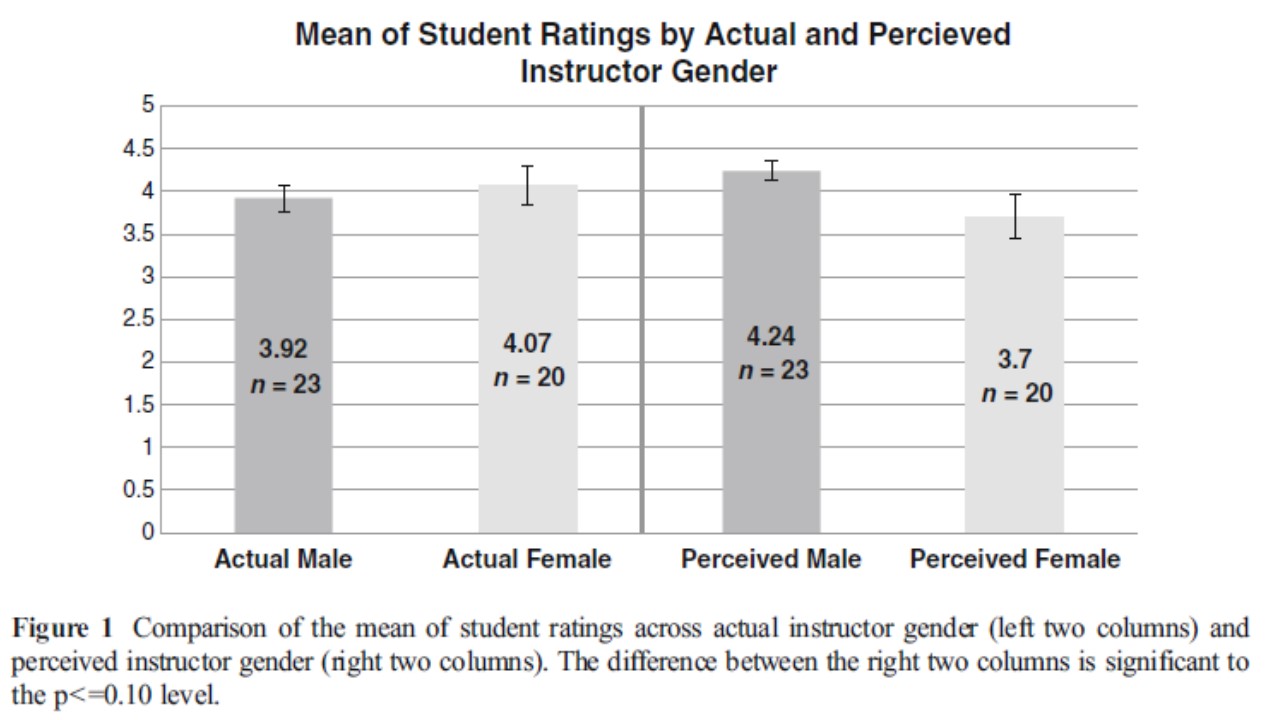
Recommendation letters reflect gender bias
K. Dutt, D. L. Pfaff, A. F. Bernstein, J. S. Dillard, C. J. Block, 2016
Gender differences in recommendation letters for postdoctoral fellowships in geoscience, Nature Geoscience 9, 805 - 808 (2016) DOI:10.1038/ngeo2819
Abstract: An analysis of an international data set of 1,224 recommendation letters, submitted by recommenders from 54 countries, for postdoctoral fellowships in the geosciences over the period 2007 - 2012. We examine the relationship between applicant gender and two outcomes of interest: letter length and letter tone. Our results reveal that female applicants are only half as likely to receive excellent letters versus good letters compared to male applicants. Male and female recommenders do not differ in their likelihood to write stronger letters for male applicants over female applicants. Letter tone for women and men applicants appears to be equivalent across all world regions, although there are significant regional differences in letter length (letters from the Americas being significantly longer than any other region) The results of the study suggest that women are significantly less likely to receive excellent recommendation letters than their male counterparts at a critical juncture in their career.
Gender discrimination in physics and astronomy
Two articles:
(1) R. S. Barthelemy, M. McCormick, C. Henderson 2016
Gender discrimination in physics and astronomy: Graduate student experiences of sexism and gender microaggressions, Phys.Rev.Phys.Educ.Res. 12, 020119 (2016) DOI: 10.1103/PhysRevPhysEducRes.12.020119
Abstract: Interviews with 21 women in graduate physics and astronomy programs are analyzed for their individual experiences of sexism. Although a subset of women did not report experiencing sexual discrimination, the majority experienced subtle insults and slights known as microaggressions. Other participants also experienced more traditional hostile sexism in the form of sexual harassment, gender role stereotypes, and overt discouragement. These results indicate the existence of sexism in the current culture of physics and astronomy, as well as the importance departments must put on eliminating it and educating students about sexism and microaggressions.
(2) A. J. Gonsalves, A. Danielsson, and H. Pettersson 2016
Masculinities and experimental practices in physics: The view from three case studies. A. J. Gonsalves, A. Danielsson, and H. Pettersson Phys. Rev. Phys. Educ. Res. 12, 020120 (2016) DOI: 10.1103/PhysRevPhysEducRes.12.020120
Abstract: This article analyzes masculinity and experimental practices within three different physics communities. This work is premised on the understanding that the discipline of physics is not only dominated by men, but also is laden with masculine connotations on a symbolical level, and that this limited and limiting construction of physics has made it difficult for many women to find a place in the discipline. Consequently, we argue that in order to further the understanding of gender dynamics within physics communities and enrich the current understandings about the lack of women in physics, perspectives from masculinity studies are crucial. The article draws on three different ethnographic case studies dealing with undergraduate students, graduate students, and research scientists. Gonsalves et al. carried out case studies in three different countries: a physics department at a university in Sweden; a physics department at a university in Canada; and a plasma physics laboratory at a university in the U.S. All three case studies included interviews; two also included observations of professors, staff scientists, and Ph.D. students as they conducted experiments, participated in seminars, worked in their offices, attended meetings, and interacted with each other in the lab. The U.S. case study also involved a visit to a plasma physics conference, at which eight physicists were interviewed, Gonsalves et al. interviewed both men and women, as well as students and faculty.
How Stereotypes Impact Women in Physics
N. Dasgupta, 2016
Physics 9, 87, 01 August 2016 3 pages DOI: 10.1103/Physics.9.87
This Viewpoint article summarizes the findings of the two separate studies mentioned above and puts them in context of a larger body of social science research on gender stereotyping, including the work of Claude Steele on stereotype threat and how it affects performance as well as her own publications on implicit bias. Both articles recount stories - from students and faculty - of male students making explicit sexist jokes or comments in the lab. Gonsalves et al., for example, observed one lab in which male graduate students censured their male peers for low-quality work by saying, "Don't act like a chick" - a derogatory statement equating poor performance with being a woman. Even worse, blatant sexual harassment cases have been revealed, in physics and astronomy and geoscience.
Sexual harassment in Astrophysics and other fields of science
Joan Schmelz a solar physicist and chair of the American Astronomical Society's Committee on the Status of Women in Astronomy from 2009 to 2015, heard in confidence from several women about sexual harassment they endured and a lot of the stories involved the same man. Schmelz told the women that they were not alone, and asked whether they wanted to talk to others who were in the same situation. As a consequence, four women eventually filed complaints. Eventually the option emerged of filing complaints under the legislation known as Title IX, which prohibits sexual discrimination on campuses that receive federal funding. In July 2014, the first complaints hit Berkeley, and the university completed its investigation June 2015, which became public and led to the resignation of Geoffrey Marcy, a well-known exoplanet hunter at the University of California, Berkeley. The case was leaked to the online publication BuzzFeed, and was closely followed by both AAAS Science and Nature:
US astronomers rally to end sexual harassment
A. Witze, 22 October 2015
Nature News 526, 483 - 484 (2015) DOI: 10.1038/526483a
Geoffrey Marcy has begun the process of resigning from his position at the University of California, Berkeley. The case involves Geoffrey Marcy, an exoplanet hunter at the University of California, Berkeley. A university investigation completed in June 2015 found that Marcy violated the university's sexual-harassment policies in incidents between 2001 and 2010, The lack of consequences for Marcy's past actions sparked outrage among many US astronomers. Marcy's colleagues are seeking stronger sanctions against the astronomer. Nearly all of Berkeley's astronomy faculty members released a statement on 12 October calling for Marcy to leave the faculty. Graduate students and postdoctoral fellows in the department have also weighed in with separate statements, asking - among other things - that Marcy be relieved of any interactions with undergraduate students.
Berkeley releases report on astronomer sexual-harassment case
A. Witze, 19 Dec 2015
Nature News Dec 19 2015 DOI: 10.1038/nature.2015.19068
"Although the many reported incidents span more than a ten-year period, the pervasiveness of Respondent's behavior is unusually high," the final report reads, "It cannot be overstated how Respondent's inherent influence and authority over the complainants, real or perceived, heightened the impact of his behavior on those experiencing or witnessing it." Ultimately, the report concludes that Marcy violated Berkeley's rules against sexual harassment." It is determined that Respondent's behavior was unwelcome, sexual in nature, and unreasonably impacted the complainants such that it created an intimidating, hostile or offensive learning environment, in violation of the University of California sexual harassment policies," the report says. On Nov 3 Marcy's lawyer announced his resignation effective Dec 31 2015.
And in another high-profile example, a US federal court in Minnesota is scheduled to soon hear a lawsuit brought by a raptor biologist (and former University of Minnesota graduate student) who alleges that she was subject to unwelcome sexual advances in the field. Jackie Renzetti Star Tribune MARCH 6, 2017
Evidence of sexual harassment as well as sexual assault is pervasive throughout many fields of science. For instance, the Survey of Academic Field Experiences (SAFE) survey of 666 scientists, published in 2014, (see below) documented harassment and assault occurring regularly in scientific fieldwork, mostly to early-career women.
Social behaviour: Indecent advances
V. Gewin 2015
Nature 519,251-253 (2015) DOI: 10.1038/nj7542-251a
The findings of the SAFE study (see below) have sparked more surveys that will become the basis for clear guidelines on acceptable behavior at field sites and reporting procedures. In a survey conducted at the behest of the Southeastern Archaeological Conference (SEAC), more than two-thirds of the almost 600 respondents said that they had experienced sexual harassment at a field site. Some 13% said that the harassment directly affected their careers, forcing them to change field sites, jobs or research interests, or to leave the discipline altogether. And more than one-quarter said that the harassment had stymied their careers in other ways, such as causing them to question their abilities and their future in the discipline, fearing for their safety at field sites and being reluctant to conduct field research. Unfortunately, says one of the co-authors of the SAFE study, senior people in the hierarchy are more likely to be perpetrators. They are also the people who have the power to establish appropriate behavior and what is acceptable in the work culture.
Furthermore, a slew of high-profile cases at US universities in the past few years has prompted federal directives that instruct universities to better respond to - and prevent - sexual assault on campus. As a result, there has been more attention to Title IX, the US federal law that prohibits sex discrimination (including sexual harassment or assault) on campus. More universities are forming offices that address the response to and prevention of sexual harassment and violence.
Sexual Harassment and Sexual Assault at Field Sites
K. B. H. Clancy R.G.Nelson, J. N. Rutherford, K. Hinde, 2014
Survey of Academic Field Experiences (SAFE): Trainees Report Harassment and Assault, PLoS ONE 9, e102172 2014 DOI: 10.1371/journal.pone.0102172
For many social, life, and earth science disciplines, conducting research in field settings is an integral component of scholarship. The data presented here represent the first systematic investigation of field site work environment and experiences, particularly as they relate to sexual harassment and assault. Among the 666 respondents, 77.5 % were women. Many fields of study are represented: anthropologists (about 50%), archaeologists (25%); the rest of the sample comprised biologists (N=68, 10.2%); zoologists (N=31, 4.7%); geologists (N=29, 4.4%); other life, environmental, and agricultural scientists (N=22, 3.3%); and other social scientists (N=12, 1.8%). A majority (64%, N=423/658) of all survey respondents, stated that they had personally experienced sexual harassment: i.e. inappropriate or sexual remarks, comments about physical beauty, cognitive sex differences, or other such jokes. Over 20% of respondents reported that they had personally experienced sexual assault, including rape: i.e. physical sexual harassment, unwanted sexual contact, or sexual contact in which they could not or did not give consent, or felt it would be unsafe to fight back or not give consent (N=140/644, 21.7%). The perpetrators of harassment and assault differed between men and women. the experiences of women most often occurred in the context of power differentials; half of such experiences originated from individuals senior to the target in the professional hierarchy of the research team. In contrast, those men in our sample also targeted for harassment and assault most often experienced inappropriate comments or unwanted contact originating from peers. These data are consistent with broader literature on workplace bullying and harassment.
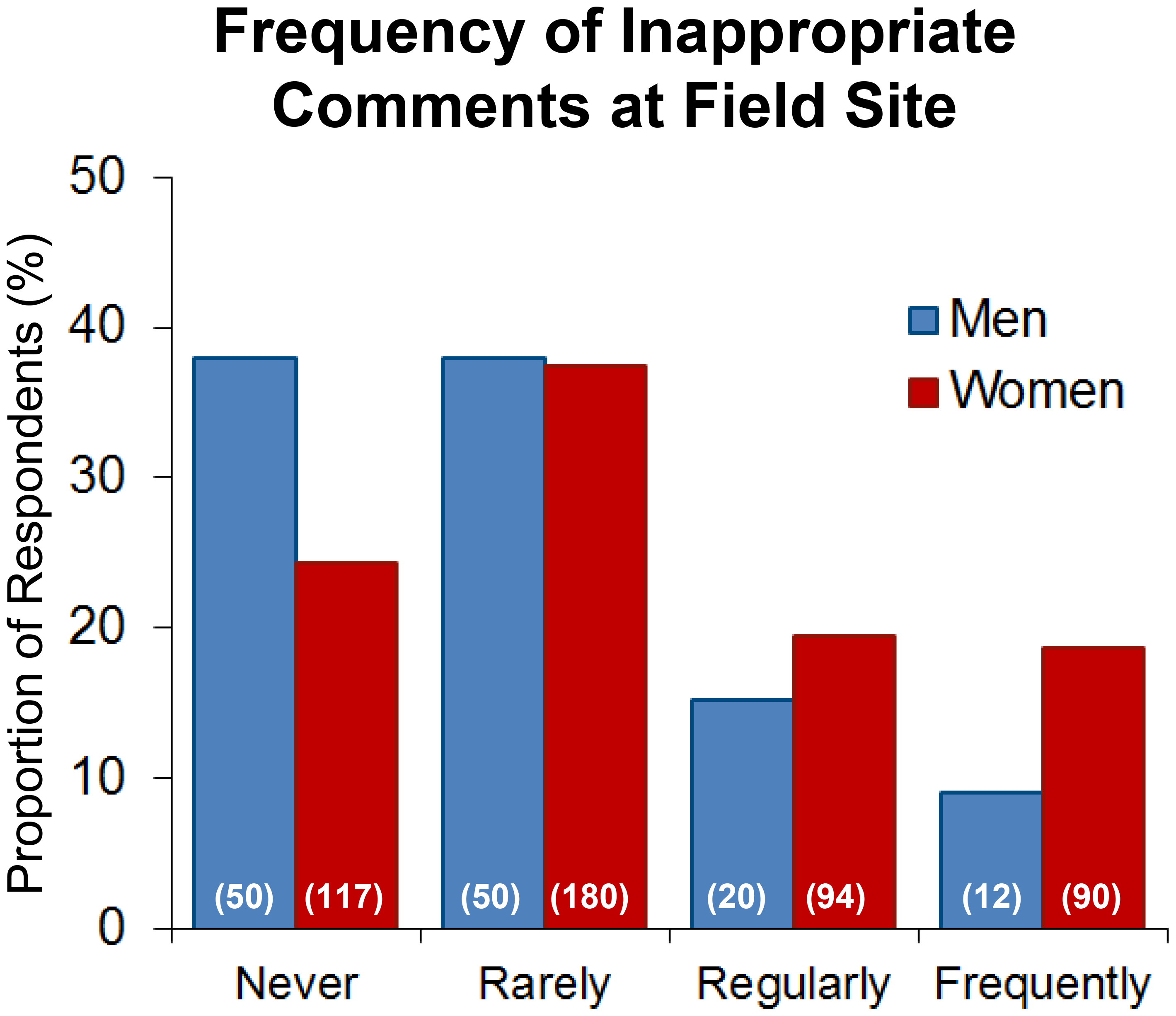
The Five Biases Pushing Women Out of STEM
Joan C. Williams
See details in Report
New research involving a survey of 557 female scientists and in-depth interviews with 60 female scientists indicate that bias, not pipeline issues, or personal choices, pushes women out of science, and that bias plays out differently depending on a woman's race or ethnicity.
The major patterns of bias are:
• Pattern 1: Prove it Again. Two thirds of the women reported having to prove themselves over and over again - their successes discounted, their expertise questioned.
• Pattern 2: The Tightrope between being seen as too feminine to be competent, and too masculine to be likable, with attendant backlash for displaying stereotypically "masculine" behaviors like speaking their minds directly or being decisive.
• Pattern 3: The Maternal Wall: When Professional women have children their commitment and competence are questioned.
• Pattern 4: Tug of War between women who feel they are competing for the "woman's spot".
• Pattern 5: Isolation: applies primarily to black and Latina women.
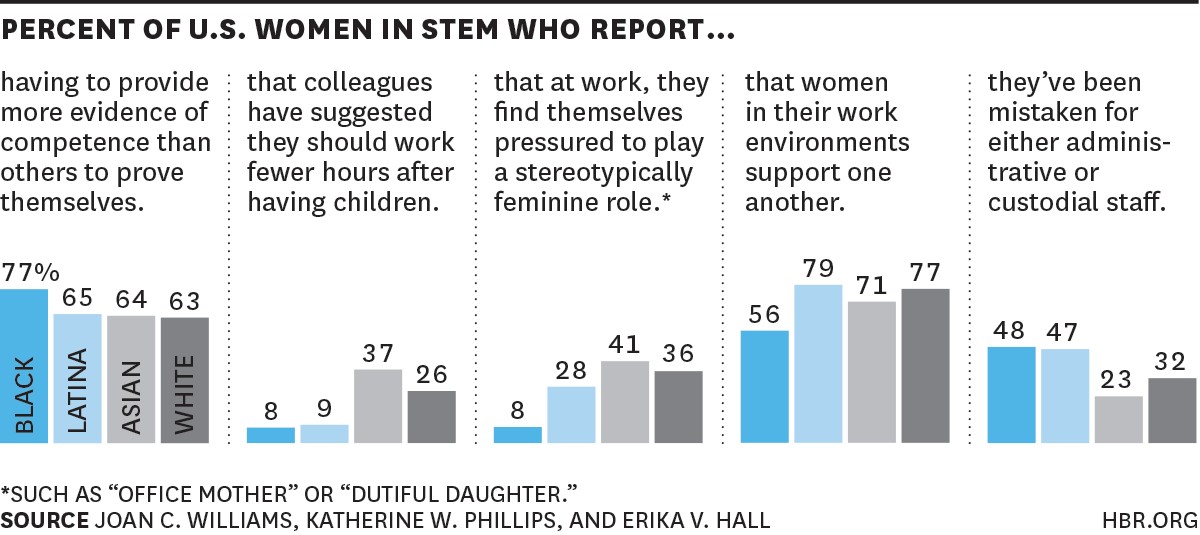
Understanding the Gender Gap in Entrepreneurship in STEM fields
M. E. Blume-Kohout, MBK Analytics, LLC, Oct 2014
Contributing factors are: The gender gap persists for women-owned businesses. While women-owned businesses contribute significantly to the small business economy, they continue to be smaller, less profitable, and more short-lived than their male-owned counterparts.
The gender gap persists for women in STEM fields, in particular the most entrepreneurial fields of bioengineering, mechanical, civil engineering and materials science. For example, women mechanical engineers represent only 6 % of that workforce. Some interesting correlations have been found in data from a combination of sources: in high-technology industries, women are more likely to start firms that provide research and consulting services and are less likely to start firms in semiconductor and aerospace manufacturing, navigational instruments or communications equipment, which may correlate with lower reported rates of R&D activities for women STEM PhDs. High-tech women-owned businesses may also be less likely to locate in geographic regions where they can take advantage of regional clustering of highly skilled labor and knowledge spillovers. Across all STEM fields, female PhDs have lower rates of patenting and entrepreneurship than do male PhDs. Female graduate students in chemical and mechanical engineering disproportionately enroll in programs with no industry-funded R&D. Female graduate students disproportionately enroll in programs with relatively higher shares of female faculty. This tendency also correlates with female students' disproportionate enrollment in lower-ranked and less research-intensive programs. Within STEM fields, PhD-granting programs in which private sector sources fund a higher percentage of full-time graduate students tend also to have a significantly lower representation of female students.
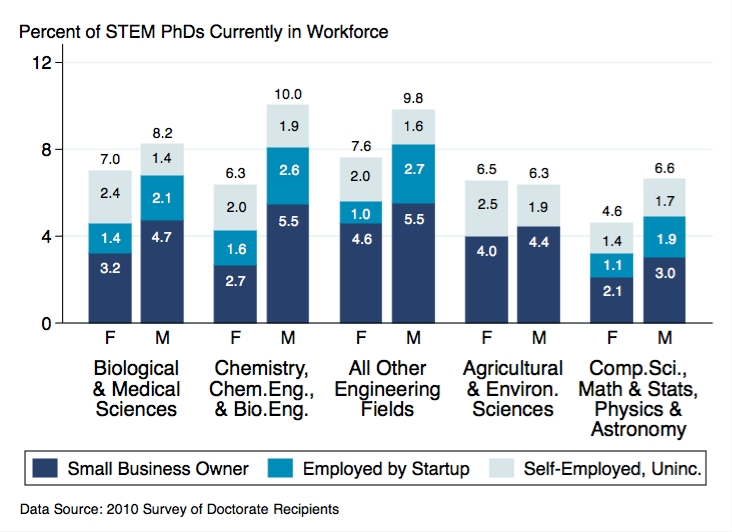
Elite male faculty in the life sciences employ fewer women
J. M. Sheltzer, J. C. Smith, 2014
Proc. Natl. Acad. Sci.USA 111(28) 10107-10112 (2014) DOI: 10.1073/pnas.1403334111
Abstract: High-achieving faculty members who are male train 10-40% fewer women in their laboratories relative to the number of women trained by other investigators. These skewed employment patterns may result from self-selection among female scientists or they may result from conscious or unconscious bias on the part of some faculty members. The dearth of women who are trained in these laboratories likely limits the number of female candidates who are most competitive for faculty job searches.
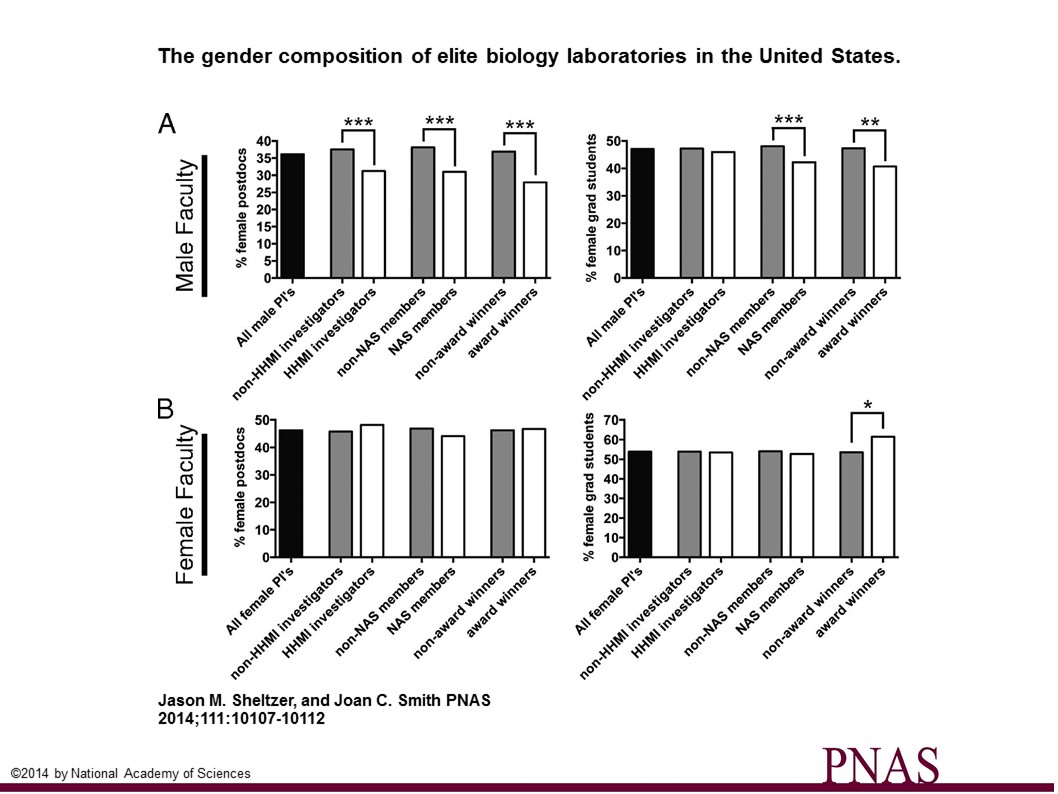
STEMing the Tide. Girls and Women in STEM
N. Dasgupta and J. G. Stout, 2014
Girls and Women in Science, Technology, Engineering, and Mathematics: STEMing the Tide and Broadening Participation in STEM Careers, Policy Insights Behav. Brain Sci. 1, 21 (2014). DOI: 10.1177/2372732214549471
This article describes how specific learning environments, peer relations, and family characteristics become obstacles to STEM interest, achievement, and persistence in each of three developmental periods: three developmental periods: (a) childhood and adolescence, (b) emerging adulthood, and (c) young-to-middle adulthood.
Mind the Gender Gap
H. Shen 2014
Inequality quantified: Mind the gender gap. H. Shen, Nature 2013 495(7439) 22-24 DOI: 10.1038/495022a
Despite improvements, female scientists continue to face discrimination, unequal pay and funding disparities, as illustrated by 1973-2008 gender breakdown of data for US scientists in Academia in Physical Sciences, Mathematics, Computer Sciences, Life Sciences, Psychology, Social Sciences and Engineering, separately for full-time senior faculty, full-time junior faculty, other full-time positions, post-docs and part-time positions.
The Gender Gap in Scholarly Publishing
J. D. West, J. Jaquet, M. M. King, S. J. Correll, C. T. Bergstrom, 2013
The Role of Gender in Scholarly Authorship, J. D. West, J. Jaquet, M. M. King, S. J. Correll, C. T. Bergstrom, PLoS ONE 8(7), e66212. July 22, 2013 DOI: 10.1371/journal.pone.0066212
Abstract: A large-scale analysis based on over eight million papers across the natural sciences, social sciences, and humanities reveals a number of understated and persistent ways in which gender inequities remain. For instance, even where raw publication counts seem to be equal between genders, close inspection reveals that, in certain fields, men predominate in the prestigious first and last author positions. Moreover, women are significantly underrepresented as authors of single-authored papers.
Do Babies Matter?: Gender and Family in the Ivory Tower
M. A. Mason, N. H. Wolfinger, M. Goulden, 2013
This book (Rutgers University Press, 2013) explores the role of family formation in discouraging women from pursuing graduate degrees and becoming faculty members in the sciences. It addresses "the baby penalty," (how women with children are far less likely to receive tenure than childless women or men with or without children).
Presumed Incompetent: The Intersections of Race and Class for Women in Academia
G. Gutierrez y Muhs, Y. F. Niemann, C. G. Gonzalez, A. P. Harris, editors, 2012
This book (Utah State university Press, 2012) is an account of the intersecting roles of race, gender, and class in the working lives of women faculty of color. Through personal narratives and qualitative empirical studies, more than 40 authors expose the daunting challenges faced by academic women of color as they navigate the often hostile terrain of higher education, including hiring, promotion, tenure, and relations with students, colleagues, and administrators.
Strengthening Canada's Research Capacity: The Gender Dimension
Council of Canadian Academies, 2012
252 page report by The Expert Panel on Women in University Research, The Council of Canadian Academies, 2012, Printed in Ottawa. ISBN 978-1-926558-50-9
The report responds to the following: What policies and what societal, cultural, and institutional, economic, and/or other relevant factors influence the career trajectory of women researchers in Canadian universities and underlie gender disparities observed in Canadian university researcher's statistical profile, by discipline area, rank, duty/position/stature, salary, tenure, research funding and or/any other relevant indicators?
Science faculty's subtle gender biases favor male students
C.A. Moss-Racusin, J.F. Dovidio, V.L. Brescoll, M.J. Graham, J. Handelsman, 2012
Science faculty's subtle gender biases favor male students . Proc. Natl Acad. Sci. USA 109, 16474-16479 (2012).
In a randomized double-blind study (n = 127), science faculty from research-intensive universities rated the application materials of a student-who was randomly assigned either a male or female name-for a laboratory manager position. Faculty participants rated the male applicant as significantly more competent and hireable than the (identical) female applicant. These participants also selected a higher starting salary and offered more career mentoring to the male applicant. The gender of the faculty participants did not affect responses, such that female and male faculty were equally likely to exhibit bias against the female student. Mediation analyses indicated that the female student was less likely to be hired because she was viewed as less competent.
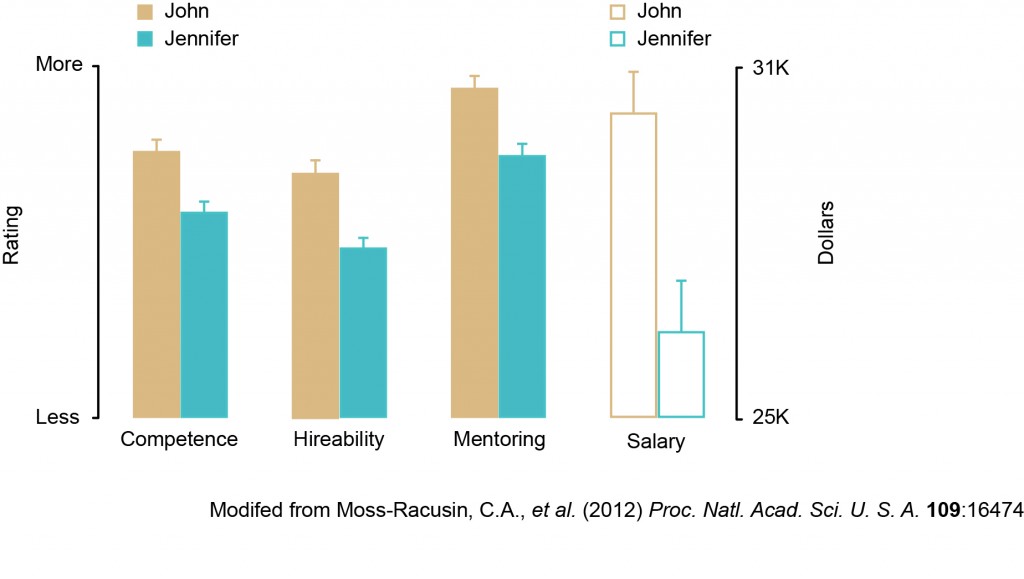
New Book by Sue Rosser
Breaking Into the Lab: Engineering Progress for Women in Science, Sue V. Rosser, 2012 New York Univ Press 260 pages.
Sue V. Rosser, Provost, Vice President for Academic Affairs, and Professor of Women and Gender Studies and Sociology at San Francisco State University, examines the historical bias women in science have faced and the progress that has been made thus far.
Does Doing All the Right Things Really Get Women Ahead?
N. M. Carter, C.Silva (Catalyst, 2011)
The Myth of the Ideal Worker: Does Doing All the Right Things Really Get Women Ahead?
Founded in 1962, Catalyst is the leading nonprofit membership organization expanding opportunities for women and business. Although their reports address women in the private sector rather than academia, their findings are relevant; there are parallels in most gendered aspects between academia and the private sector.
Abstract: This report address the question of whether the gender gap persists because women and men adopt different strategies to advance their careers. Is it the case that men are more proactive, articulating their aspirations and asking for more opportunities? Are men more likely to be an "ideal worker," doing "all the right things" to get ahead? The short answer is no. The authors studied 3,345 high potentials in this report, each of whom stayed on a "traditional" career path following graduation from a full-time MBA program. Among the high potentials we studied, more than half of both women and men had adopted the full range of advancement strategies attributed to an ideal worker. Furthermore, half of those exemplifying an ideal worker were also including in their repertories external scanning activities- seeking advancement opportunities whether in their current organization or elsewhere. However, men benefitted more than women when they adopted the proactive strategies of the proverbial ideal worker. Even when women used the same career advancement strategies-doing all the things they have been told will help them get ahead-they advanced less than their male counterparts and had slower pay growth.
Worldwide study finds few gender differences in math abilities
January 5, 2010
Girls around the world are not worse at math than boys, even though boys are more confident in their math abilities, and girls from countries where gender equity is more prevalent are more likely to perform better on mathematics assessment tests, according to a new analysis of international research.
"Stereotypes about female inferiority in mathematics are a distinct contrast to the actual scientific data," said Nicole Else-Quest, PhD, a psychology professor at Villanova University, and lead author of the meta-analysis. "These results show that girls will perform at the same level as the boys when they are given the right educational tools and have visible female role models excelling in mathematics."
The results are reported in the latest issue of Psychological Bulletin, published by the American Psychological Association. [Nicole M. Else-Quest, Janet Hyde, Marcia C. Linn. Psychological Bulletin, 2010, 136(1): 103-127 Cross-National Patterns of Gender Differences in Mathematics: A Meta-Analysis] The finding that girls around the world appear to have less confidence in their mathematical abilities could help explain why young girls are less likely than boys to pursue careers in science, technology, engineering and mathematics.
Else-Quest and her fellow researchers examined data from the Trends in International Mathematics and Science Study and the Programme for International Student Assessment, representing 493,495 students ages 14-16 from 69 countries. Both studies' results were released in 2003, and not all countries participated in both assessments. The TIMSS focuses on basic math knowledge, while the PISA test assesses students' ability to use their math skills in the real world. The researchers felt these two tests offered a good sampling of students' math abilities.
While these measures tested different math abilities, there were only small gender differences for each, on average. However, from nation to nation, the size of the gender differences varied a great deal.
The two studies also assessed students' level of confidence in their math abilities and how important they felt it was to do well in math in order to have a successful career. Despite overall similarities in math skills, boys felt significantly more confident in their abilities than girls did and were more motivated to do well.
"Cross-National Patterns of Gender Differences in Mathematics: A Meta-Analysis," Nicole M. Else-Quest, PhD, Villanova University; Janet Shibley Hyde, PhD, University of Wisconsin-Madison; Marcia C. Linn, PhD, University of California, Berkeley. Psychological Bulletin, Vol. 136, No. 1.
Source: American Psychological Association
Women Use Science, Engineering, to Pierce Vitreous Ceiling
“Consider, for example, the range of initiatives at the National Institutes of Health, which has found that although women fare well with regard to winning training grants and fellowships, they do poorly compared to men when it comes to making the transition from student/postdoc to career scientist—in many cases because of time constraints imposed by child-rearing:
• NIH has doubled the time allowed for parental leave on the certain training fellowship awards.
• NIH has provided guidance to research institutions on allowable ways to include child-care reimbursement and parental leave for scientists getting NIH grants, making it easier for grantees to remain in the scientific workforce while they build their families.
• NIH has provided supplements to postdocs who have left the scientific workforce for family reasons, to help them re-enter the scientific professional community.
• In the intramural program, NIH has “extended the clock” on the tenure-track process, to accommodate family leave. This helps women who are balancing their scientific and family responsibilities to achieve their tenure-track goals and transition to career scientists.”
Source: Office of Science and Technology Blog by Rick Weiss posted October 20, 2009
Professor Interrupted: Gender Differences in High Level Engineering, Science and Math Institutions
June 12, 2009 by Mary Anne Simpson
An exhaustive study entitled "Gender Differences at Critical Transitions in the Careers of Science, Engineering and Mathematics Faculty (2009)" published by The National Academies Press finds improvements in the representation of women in Science and Engineering at the PhD level. However, there remain significant gaps in the representation of women in certain disciplines at the Associate and Full Professor level in R1 and R2 institutions. Interestingly, women candidates applying to the very top level R1 institutions fare better than R2 institutions. The 2009 study, which includes surveys from 1800 departments for the period of the mid-1990s to 2005, updates currents interim studies and supplements the 1999 report, "A Study on the Status of Women in Science at MIT. There has been growth in the representation of women in tenure track academic positions in major research institutes. However, as of 2003 women only represent between 6 and 29% of all Associate and Full Professor in science and engineering. In some disciplines women simply do not apply.
Preparing women for careers in upper level, R1 institutions may begin as early as middle school and high school. The study examines key periods of transition for a career including applicant pool, hiring, retention, social fraternization and presents a mix bag of equality in opportunities but disparity in the overall end results. The 154-page report with nearly 200 pages of appendices should be prime reading material for academic institutions with a desire to meet the challenges of the 21st century.
Source: Gender Differences at Critical Transitions in the Careers of Science, Engineering and Mathematics Faculty (The National Academies Press 2009)
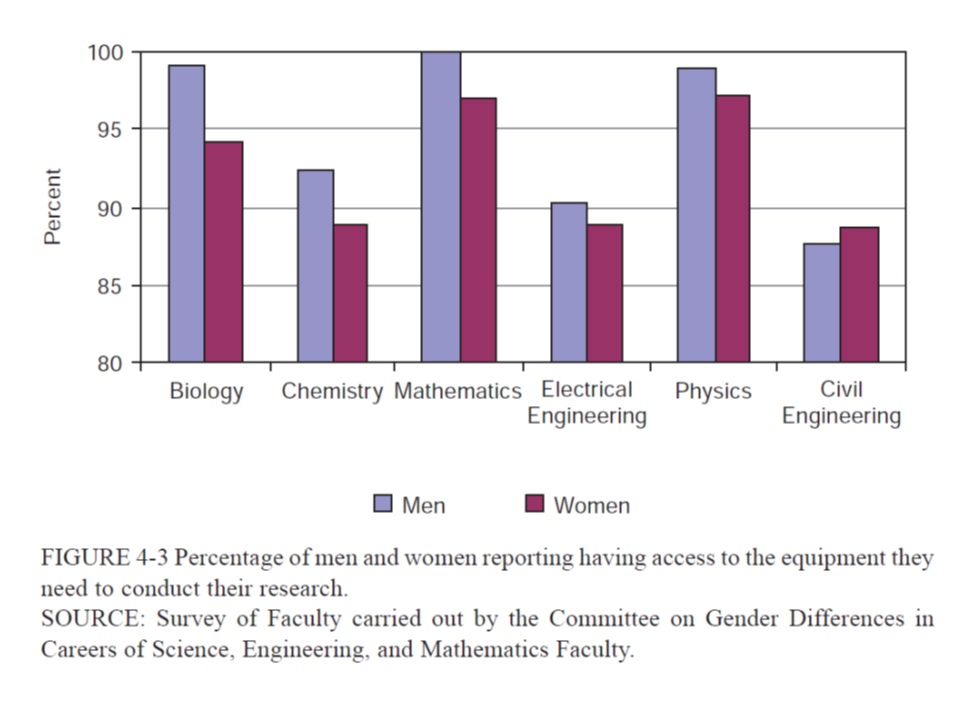
Culture, not biology, underpins math gender gap
June 1, 2009
For more than a century, the notion that females are innately less capable than males at doing mathematics, especially at the highest levels, has persisted in even the loftiest circles.
This was one of the primary reasons posited in 2005 by Lawrence Summers, then president of Harvard University and economic adviser to President Barack Obama, for the extreme scarcity of tenured women math professors in top-ranked research universities in the U.S.
Now, however, in an analysis of contemporary data published (June 1 2009) in the Proceedings of the National Academy of Sciences, researchers from the University of Wisconsin-Madison report that the primary cause for the gender disparity in math performance at all levels is culture, not biology. [Janet S. Hyde and Janet E. Mertz, Gender, culture, and mathematics performance, Proc. Natl. Acad. Sci. USA 2009, 106, 8801-8807]
"It's not an innate difference in math ability between males and females," says Janet Mertz, a UW-Madison professor of oncology and one of the authors of the article that analyzes and summarizes recent data on math performance at all levels in the United State and internationally. "There are countries where the gender disparity in math performance doesn't exist at either the average or gifted level. These tend to be the same countries that have the greatest gender equality."
In the new PNAS report, Mertz and UW-Madison professor of psychology Janet Hyde set out to answer three key questions: Do gender differences in math performance exist in the general population? Do gender differences exist among the mathematically talented? Do females exist who possess profound mathematical talent? The answers, according to the Wisconsin researchers, are no, no and yes.
Using disparate but complimentary sources of data — ranging from state standardized tests used to assess student performance under the No Child Left Behind Act to the transnational Programme for International Student Assessment to the elite International Mathematical Olympiad — the Wisconsin researchers document a pattern of performance that strongly suggests that the root of gender disparity in math can be pegged to changeable sociocultural factors. Such factors either discourage or encourage girls and young women in the pursuit of the skills required to master the mathematical sciences.
In the United States, girls at all grade levels now perform on a par with boys on the standardized mathematics tests required of all students. Moreover, U.S. girls are now taking calculus in high school at the same rate as boys, and the percentage of U.S. doctorates in the mathematical sciences awarded to women has climbed to 30 % in the 21st century, up from a nadir of 5 % in the 1950s.
Among the mathematically gifted, there are still more boys being identified than girls in the U.S., but the gap is narrowing and will likely continue to close as broader issues of gender inequity are addressed in American society. "On average, girls have reached parity with boys in the United States and some other countries, and the gender gap at the high end is closing," says Hyde.
In their report, Mertz and Hyde challenge the validity of the greater male variability hypothesis, invoked by Summers, which says that males are biologically more variable than females in math ability, thus accounting for why more males are found with very high math skills.
Contradicting this assertion, the Wisconsin researchers show that girls' math scores are as variable as boys' in some countries and among some ethnic groups in the U.S., with as many girls as boys scoring above the 99th percentile in some cultures. Thus, greater male variability in math performance is not a ubiquitous phenomenon. Rather, Hyde and Mertz report that the ratio of girls to boys excelling in math correlates quite well with measures of a country's gender equity.
"If you provide females with more educational opportunities and more job opportunities in fields that require advanced knowledge of math, you're going to find more women learning and performing very well in mathematics," says Mertz.
"U.S. culture instills in students the belief that math talent is innate; if one is not naturally good at math, there is little one can do to become good at it," Mertz adds. "In some other countries, people more highly value mathematics and view math performance as being largely related to effort."
The difference in attitude is likely a major reason the median scores of girls as well as boys in some East Asian countries are higher than the top 10 % of both boys and girls in the U.S. on standardized transnational math tests. Children of immigrants from these countries, girls as well as boys, tend to excel in math even while being raised and educated in the U.S.
While the gender gap in math performance seems to be narrowing, Hyde and Mertz caution that the United States may fall further behind other nations in math performance as tests mandated by No Child Left Behind include almost no questions requiring complex problem-solving.
" In the new report, Mertz and UW-Madison professor of psychology Janet Hyde set out to answer three key questions: Do gender differences in math performance exist in the general population? Do gender differences exist among the mathematically talented? Are there females with profound mathematical talent?
The answers, according to the Wisconsin researchers, are no, no and yes.
The researchers studied various sets of data, such as the state standardised tests used to assess student performance under the No Child Left Behind Act, the transnational Programme for International Student Assessment, the elite International Mathematical Olympiad. They found a pattern of performance that strongly suggests that social and cultural factors are the main cause of differences in maths performance between males and females.
These factors either discourage or encourage girls and young women in their pursuit of the skills needed to master maths.
In the United States, girls at all grade levels now perform on a par with boys on the standardised mathematics tests all students take. Moreover, U.S. girls are now taking calculus in high school at the same rate as boys, and the percentage of doctorates in the mathematical sciences awarded to women in the US has climbed to 30%, from just 5% in the 1950s.
Among the mathematically gifted, more boys are still being identified than girls in the US. But the gap is narrowing and will likely continue to close as gender inequity in all areas continues to be tackled. "On average, girls have reached parity with boys in the United States and some other countries, and the gender gap at the high end is closing," says Hyde.
Source: University of Wisconsin-Madison
Women opt out of math/science careers because of family demands
Women tend to choose non-math-intensive fields for their careers -- not because they lack mathematical ability, but because they want flexibility to raise children or prefer less math-intensive fields of science, reports a new Cornell study [Ceci, S. J., Williams, W. M., & Barnett, S. M. (2009). The underrepresentation of women in science: Sociocultural and biological considerations. Psychological Bulletin, 135, 172-210, 2009].
A major reason explaining why women are underrepresented not only in math-intensive fields but also in senior leadership positions in most fields is that many women choose to have children, and the timing of child rearing coincides with the most demanding periods of their career, such as trying to get tenure or working exorbitant hours to get promoted," said lead author Stephen J. Ceci, professor of human development at Cornell.
Women with advanced math abilities choose non-math fields more often than men with similar abilities, he added.
Women also tend to drop out of scientific fields -- especially math and physical sciences -- at higher rates than do men, particularly as they advance, because of their need for greater flexibility and the demands of parenting and caregiving, said co-author Wendy M. Williams, Cornell professor of human development.
"These are choices that all women, but almost no men, are forced to make," she said.
The study is an integrative analysis of 35 years of research on sex differences in math. Ceci and his Cornell co-authors reviewed more than 400 articles and book chapters to better understand why women are underrepresented in such math-intensive science careers as computer science, physics, technology, engineering, chemistry and higher mathematics.
Source: Science Daily March 13, 2009
Thirty-Three Years of Women in S&E Faculty Positions
NSF 08-308, June 2008
This NSF Infobrief examines the trends from 1973 to 2006 in the employment of women faculty and in the percentages of full professors and of tenured faculty who are women. The trends are examined by field of doctorate, Carnegie classification of employer, marital status, and the presence of children in the home. These trends are examined against the background of changing percentages of S&E doctorates earned by women over time, starting with the 1958 degree year.
Transforming science and engineering: Advancing academic women
Book by Abigail J. Stewart, Janet E. Malley, Danielle LaVaque-Manty
University of Michigan Press, 2007 376 pages
“Focusing on a wide range of topics, from how to foster women's academic success in small teaching institutions, to how to use interactive theater to promote faculty reflection about departmental culture, to how a particular department created and maintained a healthy climate for women's scientific success, the contributors discuss both the theoretical and empirical aspects of the initiatives, with emphasis on the practical issues involved in creating these approaches. The resulting evidence shows that these initiatives have the desired effects. The cases represented in this collection depict the many issues women faculty in science and engineering face, and the solutions that are presented can be widely accepted at academic institutions around the United States. The essays in Transforming Science and Engineering illustrate that creating work environments that sustain and advance women scientists and engineers benefits women, men, and underrepresented minorities.” This collection profiles 16 NSF ADVANCE grant successes.
Abigail J. Stewart is Sandra Schwartz Tangri Distinguished University Professor of Psychology and Women's Studies at the University of Michigan and author or editor of several books, including Theorizing Feminism: Parallel Trends in the Humanities and Social Sciences and Feminisms in the Academy.
Beyond Bias and Barriers: Fulfilling the Potential of Women in Academic Science and Engineering
Authors: Committee on Maximizing the Potential of Women in Academic Science and Engineering, National Academy of Sciences, National Academy of Engineering, and Institute of Medicine, 2006
The National Academies created the Committee on Maximizing the Potential of Women in Academic Science and Engineering. Specifically, the committee was charged
• To review and assess the research on gender issues in science and engineering, including innate differences in cognition, implicit bias, and faculty diversity.
• To examine institutional culture and the practices in academic institutions that contribute to and discourage talented individuals from realizing their full potential as scientists and engineers.
• To determine effective practices to ensure that women who receive their doctorates in science and engineering have access to a wide array of career opportunities in the academy and in other research settings.
• To determine effective practices for recruiting women scientists and engineers to faculty positions and retaining them in these positions.
• To develop findings and provide recommendations based on these data and other information to guide faculty, deans, department chairs and other university leaders; scientific and professional societies; funding organizations; and government agencies in maximizing the potential of women in science and engineering careers.
The report presents the findings and the recommendations.
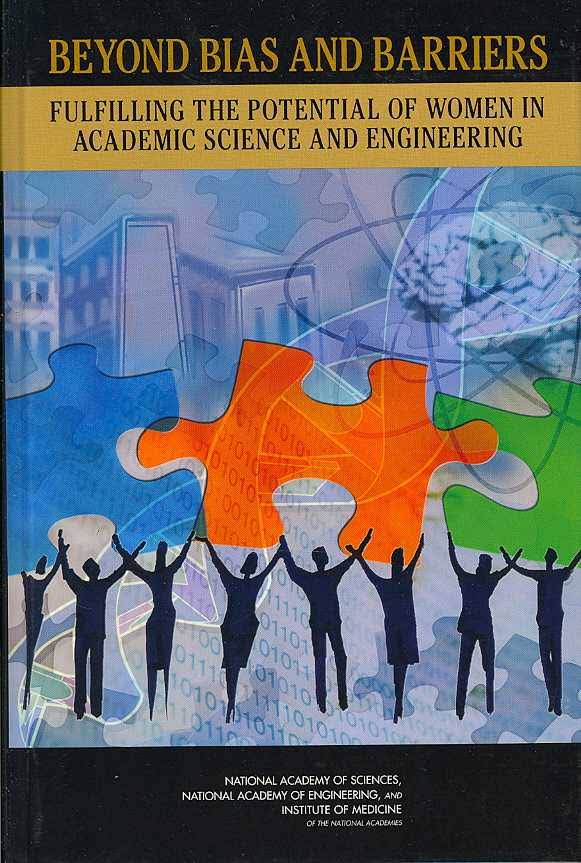
|






